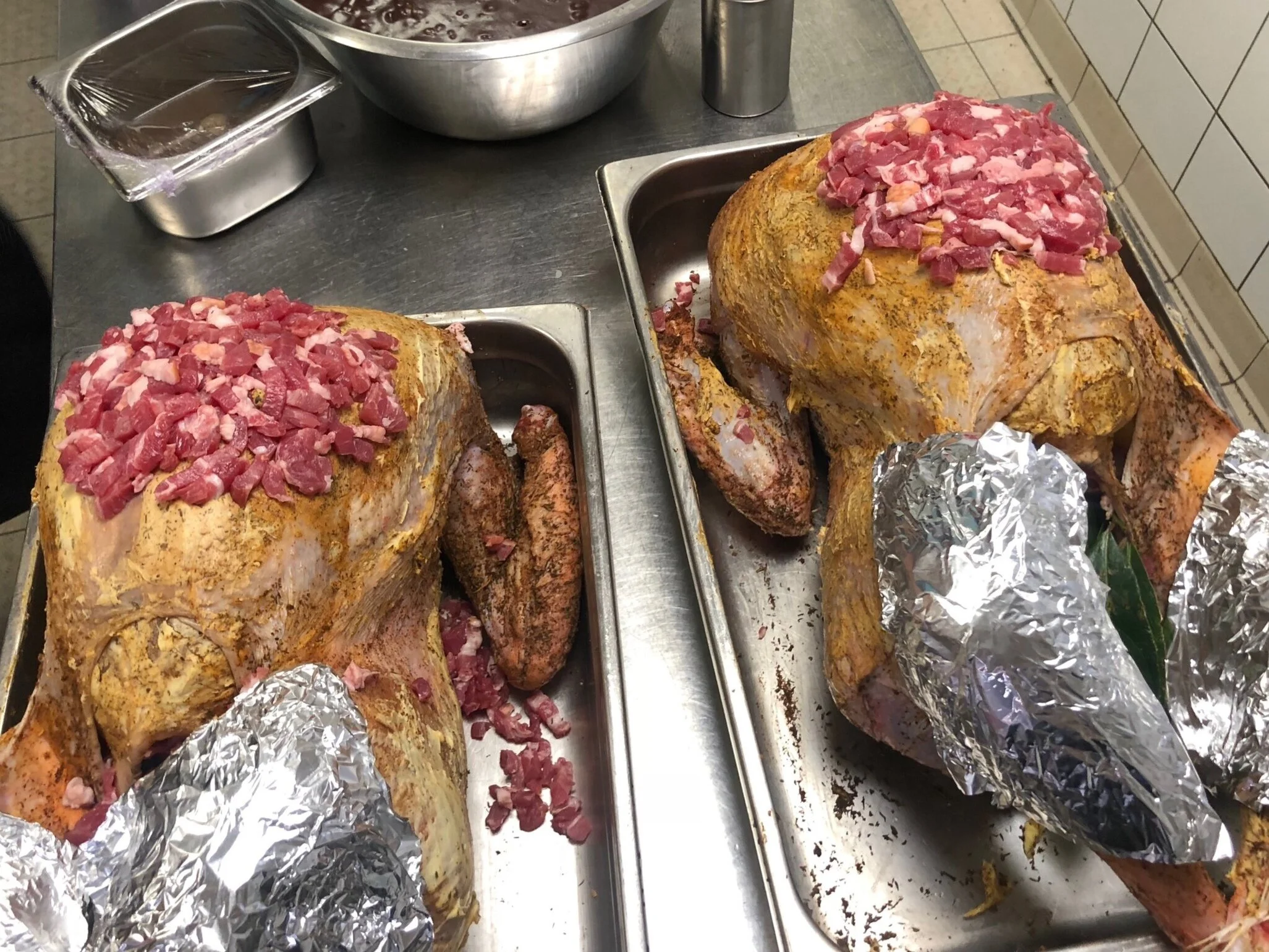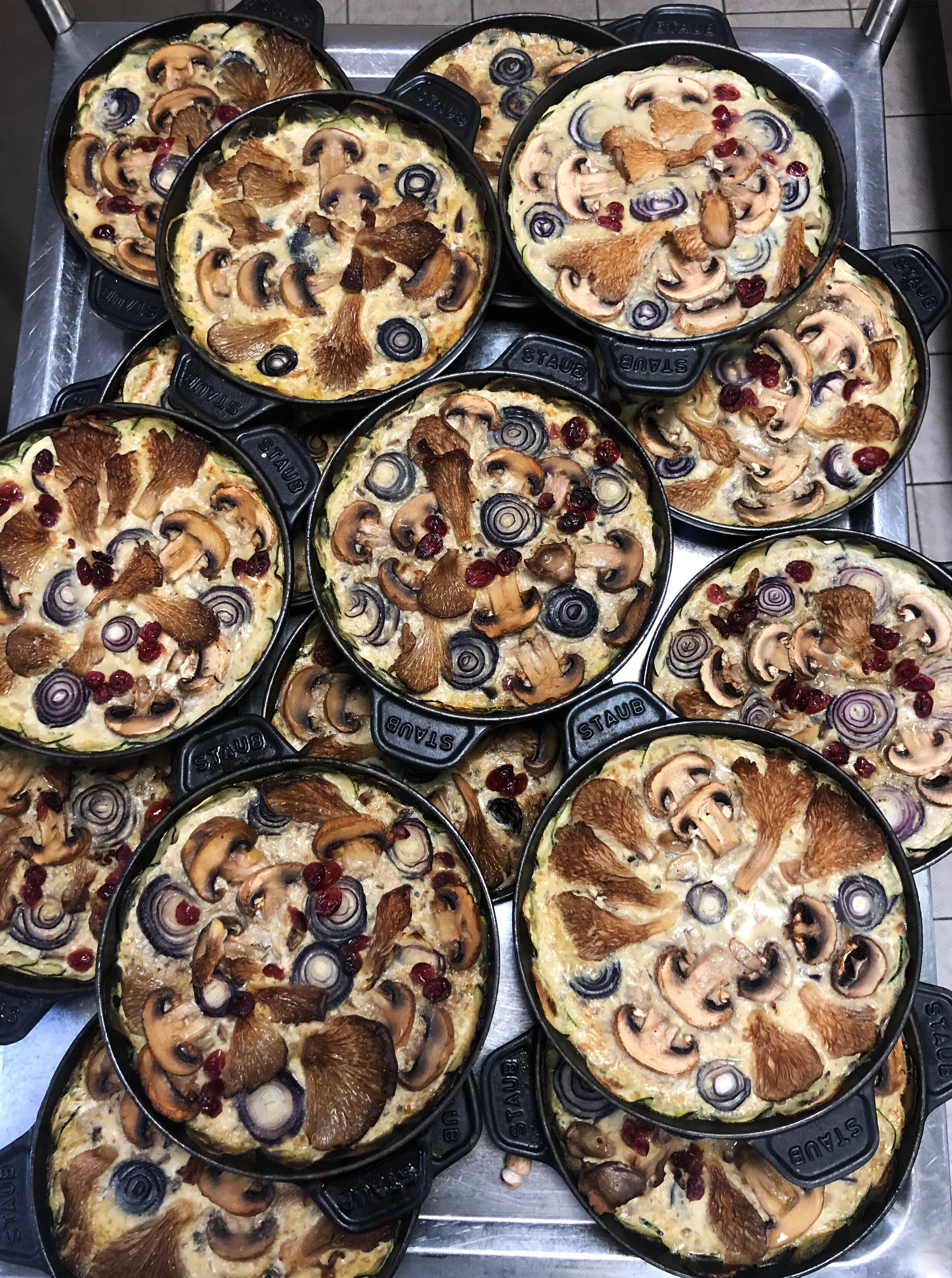Preparation
Play music while you cook!
Prep prep prep. At the very least, dice the night before. All the onions, celery, carrots... dice and separate in airtight containers (or even cook if you're feeling ambitious) the night before. Do as much as possible ahead so (some of) the day of can be spent relaxing and being with family. My Thanksgiving tradition is staying up until 3AM cooking.
Opt for several make ahead dishes. The kind that can be made a day or two ahead rather than 3am the night before…
Start brining your turkey two days or three days ahead… (Brine: Salt (mostly salt), Pepper, Powdered Garlic, Powdered chili powder, Powdered Onion, Powdered cumin, dried herbs… and rub all over the turkey and let it rest in the refrigerator for two to three days).
Turkey Tips
Dry brine your turkey… I’ve spent years making a wet brined turkey. And then after planning for a thanksgiving feast that I was preparing for 120 people at a restaurant/hotel in Paris, I spent hours watching YouTube videos on the molecular side of meat brining and the scientific evidence weighed heavily in the favor of dry brined Turkey. And it was absolute revelation. I’ve never prepared such a juicy yet crispy skinned bird. It was incredible and I’m never going back to wet brining again.
Through a process of osmosis, the salt and spices in the dry brine push the juices deep inside the bird and pull them away from the skin so that it can get nice and crisped in the oven.
Cook the bird 20 minutes per pound. Start at 400ºF and lower to 325ºF after 20 minutes.
Let the bird rest. Trust me on this one. At least an hour, or two if the bird is on the bigger side. I learned this tip from the big chefs like Gordon Ramsey who swears by it. After cooking, cover the bird with aluminium foil and then several towels to seal in the heat. It will allow the juices to be reabsorbed and render the meat incredibly juicy. If you like crispy skin, you can always put the bird back in the oven for a few minutes at 420ºF to crisp it up again.
Rub herbed butter under the skin, it will turn it into a golden crust during cooking.
Always stuff the cavity, that infuses the most flavour. Salt, pepper, butter, bacon, onions, herbs, and seal with an apple!
Cover the top of the bird with foil, or even better, with bacon (which you can use in the gravy later). Every 20-30 minutes pour broth over turkey to baste it. If using foil, remove it during the last 15 minutes of cooking and make sure to rebutter the skin one last time.
The rule is to let the bird sit for at least 20 minutes, uncovered, after you remove it from the oven to let the juices infuse, settle and will create a more moist meat. But under the advice of Chef Gordon Ramsay, I let a 10-12 pound bird rest almost two hours (tightly covered with foil and then a couple of towels to seal in heat), and as crazy as it sounds, it is absolutely incredible, tender and soft, allowing for the moisture to be fully absorbed back into the bird, and it will be piping hot by the time you serve it. Actually, Ramsay's rule is to let it sit as long as you cooked it- so around 3 hours. Do you dare try? Watch him do it here.
Make the mashed potatoes and roast the vegetables while the turkey rests. If the turkey needs around 30-45 minutes to rest, that gives you the perfect amount of time to roast vegetables (which take around 10-12 minutes in the oven at 400ºF–425ºF in the oven. And make potatoes, peel and dice ahead of time, and toss them in boiling water once you take the turkey out. When drain, and purée and add hot cream and softened butter before serving.
Buy a meat thermometer. 165ºF is considered the safe minimum internal temperature for poultry.
Skewer the thighs of the turkey a few times to help direct heat into the meat more efficiently. The faster the legs cook, the less chance you have of overcooking the breast, which cooks much faster.
Gravy
Gravy has a strangely intimidating reputation, but it's really very simple. Take all the juice and scraps in the pan after cooking the turkey. Pour it into a sauce pan, add some broth, a little flour and whisk. Add flour if too watery, and add broth if too thick and play with the balance until the right thickness is acquired. It's basically a thin roux. Fat from turkey with broth and thickener.
Always taste the pan drippings first to assess flavour and saltiness.
Make sure to cook the gravy for at least a few minutes, whisking rapidly. It needs ample mixing and cooking time in order thicken properly, otherwise you'll end up getting impatient and adding flour when what you just needed was time.
Don't add flavour immediately. As the gravy cooks it will concentrate and so will the flavours, and so will the salt.
Keep gravy warm. As it cools it will thicken and take on a pudding-like skin.
Table Aesthetics
Lighting can make up for anything. When in doubt, light tea candles and all the candles.
Create dimension. Try presenting several dishes on cake stands or the diy kind (books and a small tray) to create dimensionality and height across the table.
Instead of investing in flowers, forage barren branches and berried vines for a more wild autumnal bouquet.
To save heat space and timing stress, serve the green beans cold, in a green bean salad. Baste the fresh beans, and then dress with shallot dressing and dried cranberries.
Serve individual cranberry dishes for each guest usinga hallowed out apple.
Bring an interactive element... for dessert, make pumpkin crème Brûlée and let guests brûlée the sugar with a blow torch themselves!
Rosé with turkey. Champagne with dessert.



